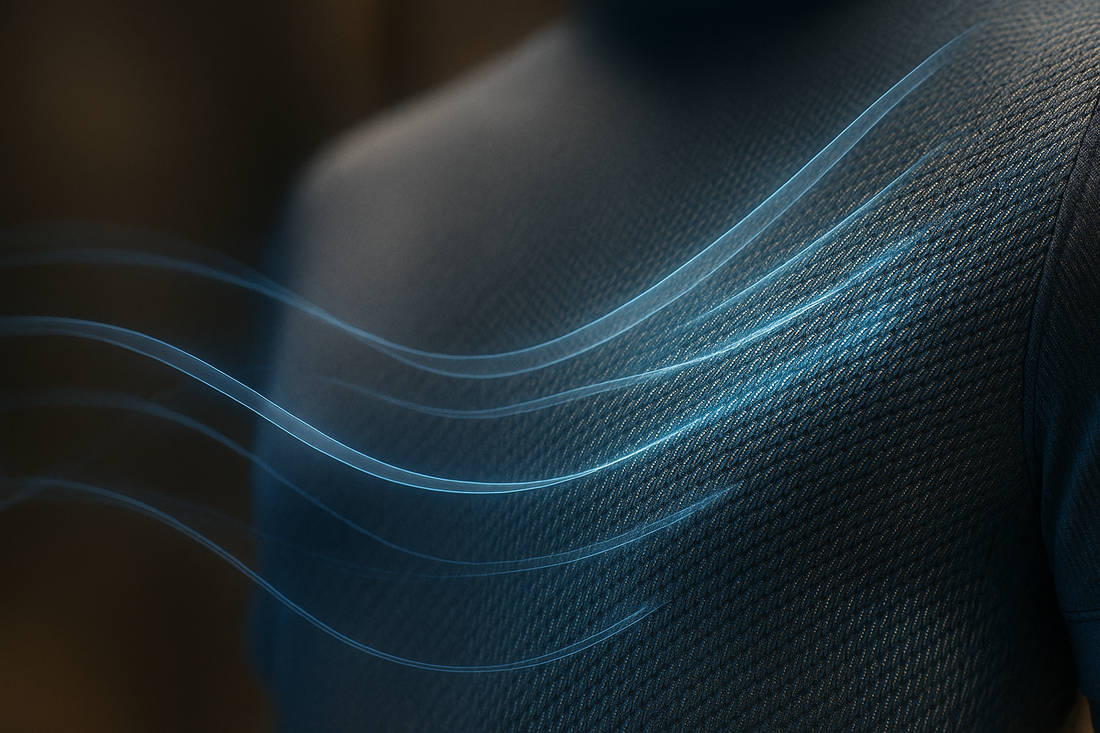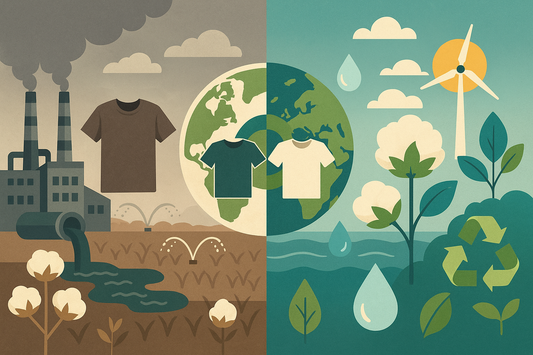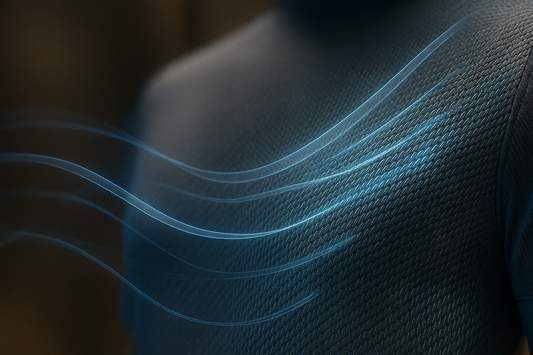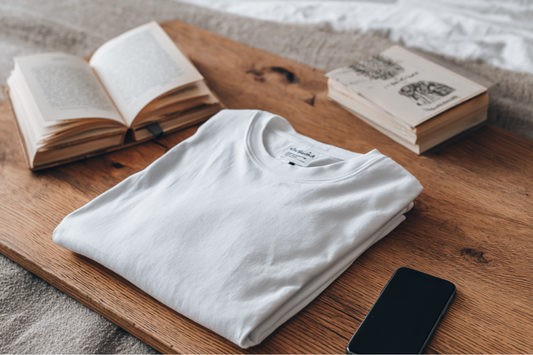
The Science Behind Fabric Breathability
Building a successful apparel brand isn't just about creating visually stunning designs or following the latest fashion trends—it's about understanding the fundamental science that makes clothing comfortable, functional, and desirable. In today's performance-driven market, fabric breathability has become one of the most critical factors influencing consumer purchasing decisions, especially in activewear, casualwear, and professional clothing segments.
Whether you're manufacturing premium cotton t-shirts, developing athletic wear, or creating everyday essentials, understanding the science behind fabric breathability is essential for product development, marketing positioning, and customer satisfaction. This comprehensive guide will explore the technical mechanisms, material properties, and practical applications that determine how well fabrics manage moisture and airflow.
In an era where consumers are increasingly educated about textile performance and comfort, brands that master breathability science gain significant competitive advantages in product quality, customer loyalty, and market positioning.
Why Fabric Breathability Matters in Modern Apparel
Before diving into the technical aspects, let's examine why breathability has become a crucial differentiator in today's competitive textile market and how it impacts both consumer experience and business success.
Consumer Comfort Revolution: Modern consumers expect clothing that adapts to their lifestyle demands. Whether working long hours in professional environments, engaging in fitness activities, or simply seeking everyday comfort, breathable fabrics directly impact wearer satisfaction and brand loyalty.
Performance Market Growth: The global performance apparel market continues expanding as consumers integrate active lifestyles with daily routines. Breathable fabrics enable this lifestyle integration by providing comfort across diverse activities and environments.
Health and Wellness Awareness: Increased awareness of skin health, thermoregulation, and moisture management has made breathability a conscious purchasing factor for health-conscious consumers across all demographics.
Climate Adaptability: With changing global climate patterns and increased urbanization, consumers need clothing that performs effectively across varying temperature and humidity conditions.
Professional Demands: Modern work environments often require long hours and varied activities, making comfortable, breathable clothing essential for professional performance and confidence.
Whether you're developing basic cotton tees, technical athletic wear, or sophisticated business casual pieces, understanding and optimizing breathability science directly translates to improved customer satisfaction, reduced returns, and stronger brand differentiation.
Understanding the Fundamentals: What is Fabric Breathability?
Fabric breathability refers to a textile's ability to allow air circulation and moisture transfer between the wearer's skin and the external environment. This seemingly simple concept involves complex interactions between fiber properties, fabric construction, and environmental conditions.
The Two Components of Breathability
Air Permeability: The rate at which air flows through fabric under specific pressure conditions. This mechanical process depends on fabric structure, fiber arrangement, and porosity levels.
Moisture Vapor Transmission: The fabric's ability to allow water vapor (perspiration) to pass through from the skin to the external environment. This process involves both absorption and desorption mechanisms at the molecular level.
The Physiological Context
Human thermoregulation relies on several mechanisms:
Radiation: Heat transfer through electromagnetic waves
Conduction: Direct heat transfer through contact
Convection: Heat transfer through air movement
Evaporation: Cooling through moisture phase change
Breathable fabrics primarily support convection and evaporation processes, enabling the body's natural cooling systems to function effectively even when clothed.
Measuring Breathability
Air Permeability Testing: Measured in cubic feet per minute (CFM) or cubic centimeters per second per square centimeter (cm³/s/cm²), indicating how much air passes through fabric under standardized pressure conditions.
Moisture Vapor Transmission Rate (MVTR): Measured in grams per square meter per 24 hours (g/m²/24hr), indicating how much water vapor passes through fabric over time.
Thermal Resistance: Measured in CLO units, indicating fabric's insulation properties and heat retention characteristics.
Wickability Index: Measures how quickly fabric transports liquid moisture away from skin through capillary action.
The Physics of Air Movement Through Textiles
Understanding the physical principles governing air movement through fabrics provides the foundation for optimizing breathability in textile design and manufacturing.
Pore Structure and Airflow Dynamics
Macro Pores: Large openings between yarns that allow direct air passage. These contribute most significantly to air permeability but can compromise fabric strength and appearance.
Micro Pores: Small spaces within fiber structures that contribute to moisture vapor transmission while maintaining fabric integrity and visual appeal.
Tortuous Pathways: The complex routes air must navigate through fabric layers, influenced by yarn twist, fabric weave, and finishing treatments.
Pressure Differential Effects
Air movement through fabric occurs due to pressure differences between fabric sides. These pressure differentials result from:
Natural Body Heat: Creates convection currents that drive air circulation Wind Effects: External air movement that enhances pressure differentials Physical Movement: Body motion that creates pumping actions, forcing air circulation through fabric
Fiber Geometry Impact
Fiber Cross-Section: Round fibers create different airflow patterns compared to trilobal, flat, or hollow fibers. Specialized cross-sections can enhance breathability while maintaining other performance characteristics.
Fiber Surface: Smooth surfaces promote different airflow characteristics than textured or modified surfaces, affecting both air permeability and moisture management.
Fiber Crimp: Natural or induced fiber crimp creates additional air spaces while potentially reducing direct airflow paths, requiring optimization for specific applications.
Material Science: How Different Fibers Affect Breathability
Different fiber types exhibit distinct breathability characteristics based on their molecular structure, surface properties, and moisture interaction behaviors. Understanding these differences enables strategic fiber selection for specific performance requirements.
Natural Fiber Breathability Characteristics
Cotton: Excellent moisture absorption (up to 25% of its weight) with good air permeability in appropriate constructions. Cotton's cellulosic structure allows moisture absorption while maintaining comfortable feel against skin.
- Advantages: Natural comfort, excellent moisture absorption, biodegradable
- Limitations: Slow drying, reduced performance when wet, potential shrinkage
- Optimal Applications: Casual wear, everyday comfort clothing, humid climate apparel
Linen: Superior air permeability due to loose weave potential and natural fiber structure. Linen's stiff fibers create natural air spaces that enhance breathability.
- Advantages: Exceptional air flow, quick drying, improves with washing
- Limitations: Wrinkles easily, can feel rough initially, limited stretch
- Optimal Applications: Summer clothing, relaxed professional wear, warm climate apparel
Wool: Unique breathability through natural fiber crimp and moisture-wicking properties. Wool can absorb significant moisture while still feeling dry to the touch.
- Advantages: Temperature regulation, odor resistance, moisture management
- Limitations: Care requirements, potential allergies, higher cost
- Optimal Applications: Performance base layers, outdoor clothing, temperature-varying environments
Synthetic Fiber Innovations
Polyester: Modern polyester variants offer excellent moisture-wicking when engineered properly. Hydrophobic nature enables quick moisture transport away from skin.
- Advantages: Durability, moisture-wicking, easy care, cost-effective
- Limitations: Odor retention, less natural feel, petroleum-based
- Optimal Applications: Athletic wear, performance clothing, moisture-management apparel
Nylon: Strong, lightweight fiber that can be engineered for excellent breathability while maintaining durability and stretch properties.
- Advantages: Strength, stretch recovery, lightweight, versatile
- Limitations: Synthetic feel, potential for static, environmental concerns
- Optimal Applications: Athletic wear, technical clothing, high-performance applications
Specialized Performance Fibers: Advanced synthetic fibers designed specifically for moisture management and breathability, including moisture-wicking polyesters, cooling nylons, and hybrid natural-synthetic blends.
Fiber Blending Strategies
Natural-Synthetic Combinations: Blending natural comfort with synthetic performance characteristics. Common ratios like 60/40 cotton-polyester optimize both breathability and durability.
Multi-Component Systems: Using different fibers in warp and weft directions or in different fabric layers to optimize specific performance characteristics.
Microfiber Integration: Incorporating ultra-fine fibers to enhance surface area for moisture management while maintaining fabric hand and appearance.
Fabric Construction and Breathability Engineering
The way fibers are assembled into fabric structures significantly impacts breathability performance, often more than fiber selection alone. Understanding construction variables enables optimization of breathability without compromising other essential fabric properties.
Weave Structure Impact
Plain Weave: Simple over-under pattern that can provide good breathability when constructed with appropriate yarn spacing and tension. Offers balance between strength and air permeability.
Twill Weave: Diagonal pattern that typically offers less air permeability than plain weave but can provide better drape and comfort while maintaining reasonable breathability.
Satin Weave: Long float construction that can enhance air permeability due to reduced interlacement points, though may compromise fabric durability.
Specialty Constructions: Mesh weaves, leno weaves, and other open constructions designed specifically for maximum air flow while maintaining fabric integrity.
Knit Structure Advantages
Jersey Knit: Basic knit structure that naturally provides excellent stretch and recovery while allowing good air circulation through the loop structure.
Rib Knit: Enhanced stretch and recovery with good breathability, particularly effective in fitted garments that need to maintain comfort during movement.
Mesh Constructions: Open knit structures designed specifically for maximum air flow, commonly used in athletic wear and performance applications.
Jacquard and Pattern Knits: Complex knit structures that can incorporate breathability zones while maintaining design aesthetics and functional performance.
For more information on the types of knitting structures
Yarn Engineering for Breathability
Yarn Twist Optimization: Lower twist levels generally improve air permeability but may compromise yarn strength. Optimal twist levels balance performance requirements.
Yarn Count Selection: Finer yarns allow closer fabric constructions while maintaining breathability, while coarser yarns create more open structures with enhanced air flow.
Textured Yarn Applications: Air-jet textured, false-twist textured, and other yarn modifications that enhance surface area and improve moisture management.
Core-Spun Technologies: Combining different fiber types in single yarns to optimize both structural and performance characteristics.
Fabric Density Considerations
Thread Count Balance: Higher thread counts generally reduce air permeability but can improve moisture-wicking through increased capillary action. Optimal density depends on intended application.
Weight-to-Breathability Ratios: Lighter weight fabrics typically offer better breathability but may compromise durability and coverage requirements.
Structural Integrity: Maintaining adequate fabric strength and appearance while optimizing breathability requires careful balance of construction parameters.
Advanced Breathability Technologies and Treatments
Modern textile technology offers numerous approaches to enhance fabric breathability beyond basic fiber and construction choices, enabling performance optimization for specific applications and market requirements.
Chemical Finishing Treatments
Moisture-Wicking Finishes: Applied treatments that enhance fiber hydrophilic or hydrophobic properties to improve moisture transport away from skin.
Anti-Microbial Treatments: Finishes that prevent bacterial growth, maintaining fabric freshness and hygiene while preserving breathability characteristics.
Phase Change Materials (PCM): Micro-encapsulated materials that absorb, store, and release heat to maintain optimal temperature regulation.
Cooling Treatments: Specialized finishes that provide cooling sensations through evaporation enhancement or endothermic reactions.
Mechanical Enhancement Techniques
Laser Perforation: Precise micro-hole creation that enhances air permeability without significantly compromising fabric appearance or strength.
Mechanical Stretching: Post-weaving treatments that open fabric structure to improve air circulation while maintaining dimensional stability.
Brushing and Raising: Surface treatments that increase air-trapping capacity while enhancing moisture-wicking through increased surface area.
Innovative Fiber Technologies
Hollow Fiber Construction: Fibers with hollow cores that provide insulation while maintaining lightweight and breathable characteristics.
Microfiber Engineering: Ultra-fine fibers that increase surface area for enhanced moisture management while maintaining fabric softness.
Bio-Component Fibers: Fibers with different polymer components that provide multiple performance characteristics in single fiber systems.
Smart Fiber Integration: Temperature-responsive fibers that adjust breathability characteristics based on environmental conditions.
Sustainable Breathability Solutions
Recycled Performance Fibers: Developing breathable fabrics from recycled materials without compromising performance characteristics.
Bio-Based Treatments: Natural and biodegradable finishing treatments that enhance breathability while meeting sustainability requirements.
Closed-Loop Manufacturing: Production processes that minimize environmental impact while maintaining high-performance breathability characteristics.
Testing and Quality Control: Measuring Breathability Performance
Reliable measurement and quality control systems ensure consistent breathability performance across production batches while enabling continuous improvement and optimization.
Standard Testing Methods
ASTM D737 Air Permeability: Measures air flow rate through fabric under specified pressure conditions, providing quantitative breathability assessment.
ASTM E96 Water Vapor Transmission: Evaluates moisture vapor transmission rates under controlled temperature and humidity conditions.
ISO 11092 Thermal and Water-Vapor Resistance: Comprehensive testing method that measures both thermal insulation and moisture transmission properties.
JIS L1096 Air Permeability Test: Japanese industrial standard for air permeability measurement, commonly used in Asian manufacturing.
Performance Benchmarking
Industry Standards: Establishing performance targets based on application requirements and competitive analysis within specific market segments.
Comfort Index Development: Creating composite scores that consider multiple breathability factors for comprehensive performance evaluation.
Wear Trial Validation: Real-world testing with target consumers to validate laboratory measurements against actual comfort perception.
Quality Control Implementation
Incoming Material Testing: Verifying fiber and yarn breathability characteristics before fabric production to ensure consistency.
Process Monitoring: Continuous monitoring of construction and finishing parameters that affect breathability performance.
Final Product Validation: Comprehensive testing of finished fabrics to ensure they meet specified breathability requirements.
Statistical Process Control: Implementing control charts and statistical analysis to maintain consistent quality and identify improvement opportunities.
Real-World Applications: Breathability Across Different Apparel Categories
Understanding how breathability requirements vary across different apparel categories enables targeted product development and effective marketing positioning.
Athletic and Performance Wear
Moisture Management Priority: Athletic wear requires maximum moisture-wicking and quick-drying capabilities to maintain comfort during intense physical activity.
Targeted Ventilation: Strategic placement of high-breathability zones in areas prone to excessive perspiration, such as underarms, back, and chest areas.
Layering System Integration: Developing base layers, mid-layers, and outer layers that work together to optimize overall system breathability and performance.
Activity-Specific Optimization: Different sports and activities require different breathability characteristics based on movement patterns, intensity levels, and environmental conditions.
Professional and Business Attire
Comfort Throughout Workday: Business clothing must maintain comfort and appearance throughout long workdays in climate-controlled environments.
Appearance Balance: Achieving optimal breathability while maintaining professional appearance, structure, and wrinkle resistance.
Seasonal Adaptability: Professional wear that performs well across different seasons and climate conditions while maintaining consistent appearance.
Care and Maintenance: Breathable professional clothing that maintains performance characteristics through repeated cleaning cycles.
Casual and Everyday Wear
All-Day Comfort: Casual wear breathability focused on general comfort across varied daily activities and environmental conditions.
Style Integration: Incorporating breathability benefits without compromising fashion aesthetics or design flexibility.
Value Positioning: Delivering breathability benefits at price points accessible to broad consumer markets.
Versatility Requirements: Casual wear that performs well across different activities, seasons, and wearing conditions.
Specialized Applications
Medical and Healthcare: Breathable fabrics for medical professionals who work long shifts in demanding environments while maintaining hygiene standards.
Industrial and Workwear: Protective clothing that provides safety features while maintaining breathability for worker comfort and productivity.
Children's Clothing: Breathable fabrics designed for active children with consideration for skin sensitivity and frequent washing requirements.
Common Breathability Challenges and Solutions
Understanding typical breathability issues and their solutions enables proactive product development and quality improvement strategies.
Manufacturing Challenges
Consistency Issues: Maintaining uniform breathability across different production batches requires careful process control and quality monitoring systems.
Solution: Implement statistical process control, standardize raw materials, and establish clear quality specifications with regular testing protocols.
Cost Optimization: Balancing breathability performance with cost requirements while maintaining profitability and market competitiveness.
Solution: Strategic fiber blending, efficient manufacturing processes, and value engineering approaches that optimize performance-to-cost ratios.
Scale-Up Difficulties: Maintaining laboratory-level breathability performance in full-scale manufacturing environments.
Solution: Pilot production testing, gradual scale-up protocols, and comprehensive process documentation and training.
Performance Optimization
Multi-Property Balance: Achieving optimal breathability while maintaining other essential properties like durability, appearance, and stretch.
Solution: Systematic testing approaches, advanced fiber technologies, and construction optimization techniques that address multiple performance requirements simultaneously.
Environmental Variability: Ensuring breathability performance across different climate conditions, humidity levels, and temperature ranges.
Solution: Comprehensive testing under varied conditions, adaptive fiber technologies, and consumer education about optimal use conditions.
Wash Durability: Maintaining breathability performance through repeated washing and care cycles.
Solution: Durable finishing treatments, fiber selection for wash stability, and care instruction optimization.
Consumer Education Needs
Performance Communication: Effectively communicating breathability benefits to consumers who may not understand technical specifications.
Solution: Develop clear, relatable messaging that connects technical performance to real-world benefits and comfort improvements.
Care Instructions: Ensuring consumers understand how to maintain breathability performance through proper care and washing.
Solution: Clear care labeling, consumer education materials, and customer service support for performance-related questions.
Market Trends and Future Innovations in Breathable Fabrics
Understanding emerging trends and technologies in breathability enables strategic planning and competitive positioning for forward-thinking apparel brands.
Emerging Technologies
Smart Fabric Integration: Fabrics that automatically adjust breathability based on environmental conditions or wearer activity levels through embedded sensors and responsive materials.
Nano-Technology Applications: Nano-scale treatments and fiber modifications that enhance breathability while providing additional performance benefits like antimicrobial properties or UV protection.
Bio-Mimetic Approaches: Fabric designs inspired by natural systems, such as tree leaves or animal skin, that optimize breathability through biomimetic structures.
3D Fabric Construction: Advanced manufacturing techniques that create three-dimensional fabric structures optimized for air circulation and moisture management.
Sustainability Integration
Circular Economy Solutions: Developing breathable fabrics from recycled materials while maintaining performance characteristics and enabling future recycling.
Bio-Based Performance: Natural and bio-derived materials engineered to provide high-performance breathability without environmental compromise.
Water-Free Processing: Manufacturing techniques that achieve breathability enhancement without water-intensive chemical treatments.
Carbon-Neutral Production: Manufacturing processes that deliver superior breathability while minimizing carbon footprint and environmental impact.
Consumer-Driven Innovations
Personalization Technologies: Custom breathability solutions based on individual physiology, activity patterns, and climate preferences.
Health Monitoring Integration: Breathable fabrics that incorporate health monitoring capabilities while maintaining comfort and performance.
Adaptive Comfort Systems: Clothing systems that automatically adjust breathability based on real-time physiological feedback and environmental conditions.
Market Evolution Patterns
Performance Democratization: High-performance breathability features becoming accessible across broader price ranges and market segments.
Category Convergence: Traditional boundaries between athletic wear, casual wear, and professional attire blurring as breathability becomes standard expectation.
Global Climate Adaptation: Breathable fabric solutions designed specifically for changing global climate patterns and extreme weather events.
Implementation Strategy: From Science to Market Success
Translating breathability science into commercial success requires systematic implementation across product development, manufacturing, quality control, and marketing functions.
Product Development Integration
Phase 1: Requirements Definition
- Define target breathability performance specifications
- Identify key application requirements and constraints
- Establish testing protocols and quality standards
- Set performance benchmarks against competitive products
Phase 2: Material Selection and Testing
- Evaluate fiber options against performance requirements
- Test fabric construction alternatives
- Validate breathability performance through laboratory testing
- Optimize construction parameters for production scalability
Phase 3: Prototype Development
- Create representative prototypes for comprehensive testing
- Conduct wear trials with target consumers
- Refine specifications based on performance feedback
- Finalize manufacturing specifications and quality standards
Phase 4: Production Validation
- Implement pilot production runs
- Validate consistency and quality control systems
- Train manufacturing teams on breathability-critical processes
- Establish ongoing quality monitoring protocols
Marketing and Positioning Strategy
Technical Communication: Develop clear, compelling messaging that translates breathability science into consumer-relevant benefits.
Performance Demonstration: Create testing demonstrations and comparative analyses that showcase breathability advantages over competitive products.
Educational Content: Produce content that educates consumers about breathability benefits and proper care for maintaining performance by using social media, blogs, and videos.
Certification and Standards: Pursue relevant industry certifications and standards that validate breathability performance claims.
Final Thoughts
The science behind fabric breathability represents a critical intersection of materials science, manufacturing engineering, and consumer comfort that directly impacts apparel brand success in today's competitive market. Understanding and optimizing breathability isn't just about technical performance—it's about creating clothing that enhances the wearer's life through superior comfort, confidence, and performance.
Successful apparel brands recognize that breathability science provides a sustainable competitive advantage that builds customer loyalty, justifies premium positioning, and drives word-of-mouth recommendations. By mastering the technical fundamentals while maintaining focus on real-world consumer benefits, brands can create products that truly differentiate themselves in crowded marketplaces.
The most effective approach combines scientific rigor with practical application, ensuring that breathability innovations translate into measurable improvements in consumer satisfaction and brand performance. This requires ongoing investment in research, testing, and quality control systems while maintaining clear focus on delivering authentic value to target customers.
As consumer awareness of textile performance continues growing, brands that demonstrate mastery of breathability science while communicating benefits clearly and authentically will capture increasing market share and customer loyalty. The science behind fabric breathability isn't just technical knowledge—it's a strategic business asset that drives sustainable competitive advantage.
Remember that breathability optimization is an ongoing process requiring continuous improvement, innovation, and adaptation to changing consumer needs and market conditions. The brands that treat breathability science as a core competency rather than a technical afterthought will lead the evolution of performance apparel across all market segments.
Need Help Optimizing Fabric Breathability for Your Brand?
At Varthagam International, we specialize in translating textile science into commercial success for apparel brands. From fabric selection and construction optimization to quality control implementation and performance marketing, we help fashion businesses like yours leverage breathability science for competitive advantage and customer satisfaction.
Our technical services include:
- Fabric breathability analysis and optimization
- Material selection and performance testing
- Manufacturing process development and quality control
- Performance validation and certification support
- Technical marketing and consumer education
- Sustainable innovation and compliance solutions
Visit Varthagam international.in or Book a Call with us or Chat with us on Whatsapp to schedule a consultation and discover how we can help you transform breathability science into measurable business results and superior customer experiences.
Ready to revolutionize your apparel performance through advanced breathability science? Let's engineer comfort that drives customer loyalty and market success.



